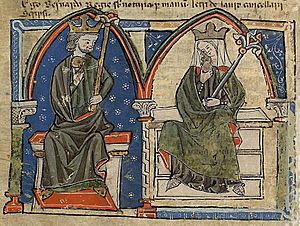Urraca of Portugal facts for kids
Quick facts for kids Urraca of Portugal |
|
|---|---|

Urraca and her husband Ferdinand II
|
|
| Queen consort of León | |
| Tenure | 1165 – 1171 or 1172 |
| Born | 1148 Coimbra |
| Died | c. 1211 Wamba, Valladolid |
| Burial | Monastery of Santa María de Wamba |
| Spouse | Ferdinand II of León |
| Issue | Alfonso IX of León |
| House | Portuguese House of Burgundy |
| Father | Afonso I of Portugal |
| Mother | Maud of Savoy |
| Religion | Roman Catholicism |
Urraca of Portugal (born 1148, died 1211) was a queen of León. She was married to King Ferdinand II of León from 1165 to 1171 or 1172. Urraca was the daughter of Afonso I of Portugal, the first king of Portugal. She was also the mother of Alfonso IX of León, who later became king. After her marriage ended, Urraca became a nun.
Early Life and Marriage
Urraca was born in the city of Coimbra, Portugal, in 1148. Her father was Afonso I of Portugal, the first king of Portugal. Her mother was Maud of Savoy. Urraca had several brothers and sisters, including Sancho I of Portugal, who later became king.
In May or June 1165, Urraca married Ferdinand II of León. They had one son together, Alfonso IX. He was born in Zamora on August 15, 1171.
The marriage between Ferdinand II and Urraca was later ended. Pope Alexander III annulled their marriage in 1171 or 1172. This happened because they were second cousins. Both Urraca and Ferdinand were great-grandchildren of Alfonso VI of León and Castile.
Life as a Nun
After her marriage was annulled, Urraca decided to become a nun. She joined the Order of Saint John of Jerusalem. She moved to live on lands that her former husband had given her. These lands were in Zamora and were part of her wedding gifts. Later, she lived in the Monastery of Santa María de Wamba. This monastery also belonged to the Order of Saint John.
On May 25, 1176, Queen Urraca gave land and villages to the Order of Saint John. This was likely around the time she officially joined the order. These properties included places like Castroverde de Campos and Mansilla in León. They also included Salas and San Andrés in Asturias.
Urraca was present in 1188 for an important event. She attended the coronation of her son, Alfonso IX. He became king after his father, Ferdinand II, died on January 22, 1188. On May 4 of that same year, Urraca and her son confirmed special rights. These rights had been given by Ferdinand II to the Order of Santiago.
The last time Queen Urraca is mentioned in old records is in 1211. In that year, she gave the village of Castrotoraf to the Cathedral of Zamora. She had received this village from Ferdinand in 1165 as a wedding gift.
Death and Burial
Queen Urraca died in Wamba, Valladolid, in 1211. She was buried at the Monastery of Santa María de Wamba. This monastery is in what is now the province of Valladolid, Spain.
Today, only St Mary's remains of the old monastery. Inside this church, there is a special area called the Chapel of the Queen. A plaque there mentions that Queen Urraca was buried in this church.
See also
 In Spanish: Urraca de Portugal para niños
In Spanish: Urraca de Portugal para niños

